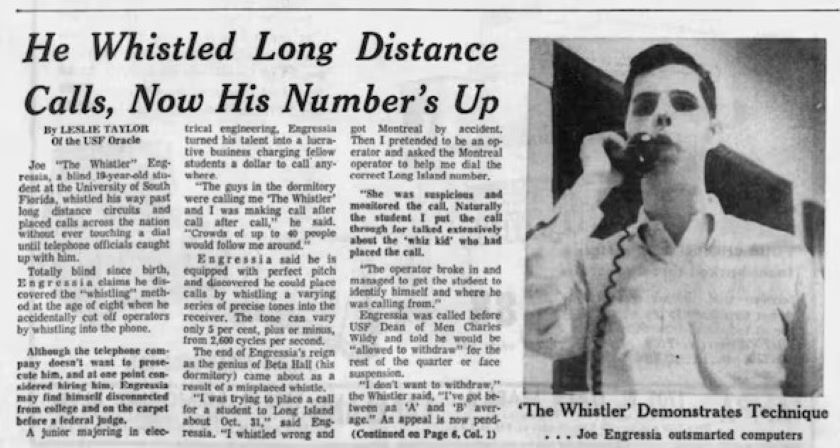A person cannot live without communication. Sharing opinions, arguing, listening or persuading is a great way to spend time. Yes, today the format of conversations has changed, we spend more time in chats and social networks, maintaining wealth in live companies, with a common voice. But just recently the picture was completely different.
With the invention of the first telegraph, and then the telephone, it became possible for people to communicate at a distance. To hear the interlocutor, you just had to pick up the handset of the device and dial the desired number.
Technology improved, and at the same time the possibility of group conversation became available. The rapid development of telephone networks in the 20th century led to the fact that not only the entire population of the world just chatted, but also the emergence of amateurs. undocumented features popular communication tools.
Brief description
Collective lines and first voice chats
Phreaking – the shadow part of telephony
Voice chats are illegal, but possible!
Useful bug of Soviet automatic telephone exchanges
Leningradsky ether
End of broadcast
Collective lines and first voice chats
 What’s new with the neighbors?
What’s new with the neighbors?
Since the end of the 19th century, telephone companies have practiced connecting customers to a collective communication line. This was true for long distances, where individual service was provided by roads. In such conditions of telephone lines, it was impossible to conduct confidential conversations – they gossiped and shared breaking news. For many corners remote from large cities and civilizations, this method of communication has become a local cultural tradition.
The development of telephony after the Second World War led to the massive introduction of collective lines. Back then it was an affordable and simple tool to quickly increase the subscriber base. But related problems immediately arise – line overload and time restrictions on call duration. Up until the late 1980s, shared lines in America still followed operating rules until the age of answering machines and modems began.
Phreaking – the shadow part of telephony
 This Blue Box was created by Wozniak himself, now the device is in the Computer History Museum
This Blue Box was created by Wozniak himself, now the device is in the Computer History Museum
The first hackers appeared when there were no computers yet. They simply hacked into completely different networks – telephone networks. And in the 1960s, an unusual idea was born in America – phreaking. The word refers to the activities of freaks who were mixed on the phones. The benefit from the illegal use of telephone networks was obvious – free calls, which, given the high tariffs, was attractive to operators.
Private enthusiasts who do not prevent anything from limiting the audio control signals for the phone. Special devices appeared – boxes, with different functionality. The key word here is free.
I also found my own legend in this community: one of the founders of phreaking knows the blind teenager Joseph Engressia. Possessing absolute pitch, he uses traditional whistles to create sound signals to make call announcements.
 The newspapers devoted articles to the talented “whistleman” Engressia
The newspapers devoted articles to the talented “whistleman” Engressia
In the 1970s, the movement only grew stronger, expanding its technical arsenal with special devices and attracting more and more young people.
Phreaking and the famous Kevin Mitnick, for whom hacking AT&T networks became the first step in his criminal career. The hacker learned to listen to other people’s conversations, call from other people’s numbers and create unregistered number operators.
Voice chats are illegal, but possible!
 1971 Freakers in action!
1971 Freakers in action!
Phone phreaking has long been a solitary activity, but I wanted to communicate with like-minded people! And then it turned out that for these purposes you can use the undocumented mode of operation of the PBX. Its activation resulted in subscribers being connected on the same line (party lines, hotlines). It was somewhat similar to working in the old collective line.
People called a certain number that was disconnected from the subscriber network outlet. In response, an audio message or beeps sounded. But all callers connected with each other in conference mode. To strengthen your voice, shout or use special amplifiers. And sometimes there were not even technical signals – in conditions of clear air it was possible to communicate calmly.
This opportunity immediately created a community of people who use party lines to communicate. An important formula for voice chats was anonymity. You could chat with each other about everything in the world and not be afraid of being recognized. The social network for phreakers was something alluring, unusual and technological. Phone companies quickly recognized the potential opportunities created at this time for his chat-based voices, paid of course.
Useful bug of Soviet automatic telephone exchanges
 Decadal-step automatic telephone exchanges – sources of surprises
Decadal-step automatic telephone exchanges – sources of surprises
The use of ten-step automatic telephone exchanges in the Soviet Union produced a similar effect. Of course, only a select few knew about it, while the rest were content with legends and rumors about this opportunity. It turned out that when calling the current number, we could also get into a voice chat and communicate with strangers. In conditions of total state control, such an opportunity became a real treasure, a breath of freedom!
The signalmen were never able to fully explain what was the reason for this behavior.”glands“. Its undocumented possibility arose either due to poor wiring, or it was generally the logic of the device’s operation, the occurrence of which its creators themselves did not even suspect. Technicians discovered the effect, but how it was corrected, it was not the cause, was unclear.
Leningradsky ether
 The door to semi-legal voice chat is ajar!
The door to semi-legal voice chat is ajar!
In the Soviet Union, voice chats became known as “Leningrad air“. Urban legends say that its first users were black marketeers. After all, on a secret telephone channel it was possible to anonymously negotiate with influential clients about a future deal, without fear of surveillance and wiretapping by the authorities. The whole scheme looked intriguing like a spy – you could call a non-existent number from a simple pay phone on the street and chat with an unknown interlocutor there.
However, it was not possible to keep the secret for long. More and more people became involved in this semi-legal, but such an interesting activity. The black marketeers, for obvious reasons, had to look for other ways of communication. But the Leningrad broadcast gained popularity as a social club. He believes that at some time tens of thousands of Leningraders used the services of the telephone bug. Those with the loudest voices turned forward, becoming chat stars.
On air using personal phones for private communication. And at night, when only enthusiasts came out, there was multivocal communication on a variety of topics. Fans of the broadcast even met live – every Saturday at the Gorkovskaya metro station to see each other in person.
Not everyone had personal phone numbers, and at work you couldn’t really chat. Therefore, the broadcasters actively used pay phones. Payment for a time-limited conversation was 2 kopecks, but the chats lasted a long time! And the trick with the fishing line, the prosecutor’s coin, justified itself perfectly in such conditions.
End of broadcast
 Queues to pay phones are a common occurrence, partly because of this
Queues to pay phones are a common occurrence, partly because of this
The signalmen saw what was happening, but could only shrug their shoulders. The load is blocking popular numbers, broadcasters are conducting research to access new ones. Telephone ether has become an additional and noticeable adapter for telephone networks – dialing has deteriorated for ordinary subscribers. Telephone operators tried to block in-demand numbers by calling busy tones or answering machines.
Where technical tools were not used, the media came to the rescue. Negative articles about Ether appeared in the press, and a documentary was made about it. However, with the help of the newspaper, those using the services themselves tried to attract attention and defend such a convenient opportunity for communication. And the Komsomol as a whole turned a blind eye to such a hobby among young people.
 By the 1990s, new hobbies and ways of communicating had emerged in New Zealand.
By the 1990s, new hobbies and ways of communicating had emerged in New Zealand.
Be that as it may, Leningrad broadcast has outlived its popularity. In the 1990s, PBX notifications began to be updated. The technology that replaced them already had almost such a popular bug. And society itself began to change – many new ways of both communication and entertainment appeared. Many readers have the word “Fidonetbrings a pleasant smile.
Interest in the broadcast began to fade. Today, only a couple of abandoned forums and social networking groups in the name remind of it, and now the word “ether” is clear.
And they even added the most magical numbers with announcements of voice chats in different cities of the country.
Source: Iphones RU
I am a professional journalist and content creator with extensive experience writing for news websites. I currently work as an author at Gadget Onus, where I specialize in covering hot news topics. My written pieces have been published on some of the biggest media outlets around the world, including The Guardian and BBC News.











